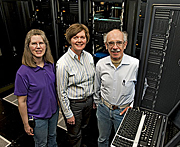- Number 313 |
- June 7, 2010
Research effort focuses on water

Ames Lab researchers
Theresa Windus, Monica Lamm
and Mark Gordon
Water may be one of the most precious substances on Earth, but scientists know less than you might think about how it behaves at the molecular level. For example, how do billions of tiny aerosol particles interact when they form clouds? What molecular changes occur within large quantities of water, and how might certain polymers clean up water when it’s contaminated?
A group of researchers from DOE's Ames Laboratory is using a DOE Innovative and Novel Computational Impact on Theory and Experiment, or INCITE, award to study these and other fundamental questions about the nature and behavior of water. The Ames Lab team was granted 8 million processor hours on an IBM Blue Gene supercomputer – one of the world’s fastest – located at Argonne National Laboratory in Illinois.
To perform their work, the group will rely on a key tool: a suite of supercomputer-enabled software programs known as the General Atomic and Molecular Electronic Structure System, or GAMESS, developed by Mark Gordon, director of the Applied Mathematics and Computational Sciences program at the Ames Laboratory and Frances M. Craig Chair in chemistry at Iowa State University.
The questions the group hopes their data will address touch on vital areas such as climate change and scarce resources. Take cloud formation, for example. As Ames Lab associate scientist Theresa Windus explains, “The composition of the aerosols determines if a cloud is made up of a lot of small particles or large particles, which in turn impacts the size of clouds, their longevity and the probability they will produce rain.”
Similarly, Monica Lamm, another member of the team who will study ways of purifying water, hopes her work will tackle an equally pressing global problem. “Clean water is going to be a huge issue as the world’s water resources become increasingly stretched in the years ahead,” Lamm says.
It’s ironic perhaps, that one of the planet’s most advanced computers will be used to study one of earth’s simplest substances. Yet for the scientists involved, the thrill of discovery remains the same. “The opportunity to have your science run on these machines is very exciting,” Lamm says, adding, “and the fact that we don’t know what the results will tell us is also exciting.”
[Mark Ingebretsen, 515-294-3474,
marki@ameslab.gov]
